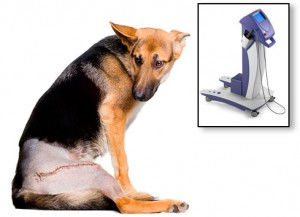
Most of us can agree that animals feel pain. However, what is more difficult to agree on is how much pain an animal is feeling. Like people, their tolerance for pain varies. For example, there are some people that are very stoic who wouldn’t flinch if you poked them with a sharp stick. Then there are those you could barely brush by who would scream as if you tortured them. Well, animals are no different in that respect. Truly the biggest difference is in the way we communicate. We, as humans, are fortunate to have the power of speech, so we can communicate when, and more importantly, where something hurts. With animals we strictly rely on body language and non-verbal cues to determine if, where, and to what extent they are experiencing pain.
It is really only in the last 20-25 years that veterinarians, as a profession, have acknowledged and accepted that animals truly feel pain, and likely, to the extent that we do. Where the challenge lies for owners and veterinarians is recognizing the signs of pain and understanding the cues our pets and patients give that suggest pain is occurring and where it is hurting.
There are obvious signs that even the most inexperienced person can use to tell that their pet is hurting: limping, protective behavior (such as nipping or vocalizing when touched in a painful area), not moving or unwilling to get up, and hesitating to jump up or climb stairs. There are lots of other signs that can indicate pain too that may not be as straight forward: not eating as much or as fast as usual, panting, hiding, sleeping more, not greeting you at the door, restlessness or an inability to lie down, not doing the normal routines, and even strange behaviors such as becoming more aggressive or engaging in inappropriate potty habits. My professional opinion is that when you notice changes such as these, it is extremely important to reach out to your veterinarian.
Like many veterinarians, I believe that treating pain in animals is the most caring and humane thing we can do and that it should not be ignored – no living being should ever have to suffer with pain needlessly. There are many tools that we have to treat, and more importantly, prevent pain in your pet. The most common treatments include nutraceuticals (ie glucosamine chondroitin), pain medications (injections, oral, topical), physical rehabilitation, massage therapy, acupuncture, and combinations of the above. Along with these, there is a newer, less common modality where we are seeing excellent results and highly recommend it in our arsenal to relieve pain.
Therapy Laser is a treatment that can be used to lessen and eliminate many types of pain. Its best use is against inflammation and swelling, which are two of the leading causes of pain. Laser therapy helps treat pain such as chronic arthritis, tendonitis, hot spots, ear infections, burns, wounds, post surgical sites, trauma and so much more. The benefits of Laser Therapy are often profound and reliable, while the actual treatment is painless, quick, and has no negative side effects.
Our family has an older, very arthritic dog and cat, so learning about the Therapy Laser and all the wonderful things it can do to lessen and even eliminate pain for pets was a profound experience. Here at Harmony Animal Hospital, we believe strongly in this treatment and are one of only two veterinary hospitals in the area that have invested in the equipment to be able to provide this service to our own and our clients’ pets experiencing pain. To learn more, visit our page on Laser Therapy.

